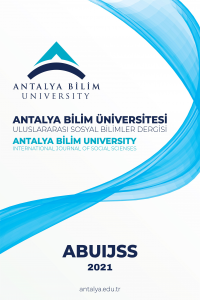Öz
Cesaret üzerine yapılan araştırmalar genellikle cesaretin karmaşık doğasını işaret etmektedir. Bu nedenle, cesaretin anlaşılması ve uygulanmasında açıklayıcı modellere ihtiyaç vardır. Bu ihtiyaçtan hareketle yapılan bu çalışmada, cesaret modellenmeye çalışılmış, şimdiye kadar cesaretle ilgili ortaya konulan bazı modeller incelenmiştir. Ayrıca, çalışma kapsamında da yeni bazı modeller ortaya konulmuştur. Çalışmanın, gerek cesaret üzerinde araştırma yapan akademisyenlere, gerekse iş yaşamında cesareti hayata geçirmek arzusunda olan lider ve yöneticilere katkı sağlayacağı değerlendirilmektedir.
Anahtar Kelimeler
Kaynakça
- Aydemir M. & Mert, İ. S. (2018). A study on the investigation of the historical origins of courage in futuwwa and akhi institution. In B. Yenihan, S. D. Basar & G. Cerev (Eds.), A critical review of social sciences: Theory and practice (pp. 543-537). London: Frontpage Publications Limited.
- Bal, M. (2018). Caydırmaya karşı Platon’un Lakhes diyaloğunda ve Aldous Huxley’in cesur yeni dünya romanında cesaret felsefesi. Mavi Atlas, 6(1), 90-130.
- Bandura, A. (1986). Social foundations of thought and action. Englewood Cliffs: Prentice Hall.
- Baynal, F. & Taşci Yıldırım, E. (2020). Cesaret erdemi bağlamında islam ahlak felsefesi ile psikoloji arasında mukayeseli bir değerlendirme. KSÜ İlahiyat Fakültesi Dergisi, 35, 137-175.
- Comte-Sponville, A. (1996). A small treatise on the great virtues: The uses of philosophy in everyday life. New York: Holt.
- Evans, P. D. & White, D. G. (1981). Towards an empirical definition of courage. Behaviour Research and Therapy, 19(5), 419–424.
- Goud, N. H. (2005). Courage: Its Nature and Development. Journal of Humanıstıc Counselıng, Educatıon and Development, 44, 102-116.
- Gruber, C. (2011). The Psychology of Courage: Modern Research on an Ancient Virtue. Integrative Psychological and Behavioral Science, 45(2), 272–279.
- Harbour, M. & Kisfalvi, V. (2012). Looking desperately for courage or how to study a polysemic concept. Qualitative Research in Organizations and Management: An International Journal, 7(2), 166–188.
- Harris, H. (2001). Content analysis of secondary data: A study of courage in managerial decision making. Journal of Business Ethics, 34 (3/4), 191–208.
- Jiang, X. (2012). Confucious’s view of courage. Journal of Chinese Philosophy, 39(1), 44–59.
- Kilmann, R. H., O’Hara, L. A. & Strauss, J. P. (2010). Measure developing and validating a quantitative of organizational courage. Journal of Business and Psychology, 25(1), 15–23.
- Klepousniotou, E., Titone, D. & Romero, C. (2008). Making sense of word senses: the comprehension of polysemy depends on sense overlap. Journal of Experimental Psychology: Learning, Memory and Cognition, 34(6), 1534-1543.
- Koerner, M. M. (2014). Courage as ıdentity work: Accounts of workplace courage. Academy of Management Journal, 57(1), 63–93.
- Maddi, S. R. (2004). Hardiness: an operationalization of existential courage. Journal of Humanistic Psychology, 44(3), 279-98.
- May, R. (1975). The courage to create. New York: Norton.
- Mert, İ . (2021). Cesaret ve bileşenlerinin keşfine ilişkin nitel bir araştırma: Eski bir erdemin yeniden keşfi. İş ve İnsan Dergisi, 8(1), 19-32.
- Mert, İ. S. & Aydemir, M. (2019). Yönetsel cesaretin tarihi kaynakları üzerine bir inceleme: Eski türk yazıtlarında cesaret. Anemon Muş Alparslan Üniversitesi Sosyal Bilimler Dergisi, 7(6), 319-328.
- Mert, İ. S. & Turgut H. (2018). Do we have the most appropriate human resource in a highly mortality salienced world? Evidence from Turkey. International Journal of Economics, Commerce and Management, 6(8), 169-180.
- Mert, İ. S. (2007). Cesaret yönetimi. İstanbul: Hayat Yayınları.
- Mert, İ. S. (2010). Terör yönetimi kuramı ve cesaret: Kavramsal bir tartışma. Güvenlik Stratejileri Dergisi, 6(12), 57-80.
- Mert, İ. S. (2018). En üstün ruhsal özelliklerimizden biri: Cesaret. Gönül Kültür ve Medeniyet Dergisi, 84, 12-19.
- Pury, C. L. S. (2008). Can courage be learned. In S. J. Lopez (Ed.), Positive Psychology: Exploring Human Strengths, 1, 109–130).
- Rachman, S. J. (1978). Fear and courage, W. H. Freeman and Company. New York: NY.
- Rate, C. R., Clarke, J. A., Lindsay, D. R. & Sternberg, R. J. (2007). Implicit theories of courage. The Journal of Positive Psychology, 2(2), 80–98.
- Ruda, F. (2017). Courage. Filozofski Vestnik, 38(2), 105–120.
- Schilpzand, P., Hekman, D. R. & Mitchell, T. R. (2015). An ınductively generated typology and process model of workplace courage. Organization Science, 26(1), 52–77.
- Shelp, E. E. (1984). Courage: a neglected virtue in the patient-physician relationship. Social Science & Medicine, 18(4), 351–60.
- Silvert, W. (2001). Modellıng as a dıscıplıne. Internatıonal Journal of General System, 30(3), 261-282,
- Simola, S. (2016). Mentoring the morally courageous: a relational cultural perspective. Career Development International, 21(4).
- Szagun, G. (1992). Age-related changes in children’s understanding of courage. Journal of Genetic Psychology, 153(4), 405–420.
- Şen, C. ve Mert, İ. S. (2020). Courage management: Courage as a management tool. İn: Social and humanities sciences: Theory, current researches, and new trends, (Eds, Babacan, H., İnan, R.,), Montenegro: IVPE.
- Tillich, P. (1959). The courage to be. New Haven: Yale University Press.
- Woodard, C. R. (2004). Hardiness and the concept of courage. Consulting Psychology Journal: Practice and Research, 56(3), 173–185.
- Woodard, C. R. & Pury, C. L. S. (2007). The construct of courage: Categorization and measurement. Consulting Psychology Journal: Practice and Research, 59(2), 135–147.
- Worline, M. C. (2012). Courage in organizations: An integrative review of the “difficult virtue.” In K. S. Cameron & G. M. Spreitzer (Eds.), Oxford handbook of positive organizational scholarship (pp. 304–315). New York: Oxford University Press.
Ayrıntılar
| Birincil Dil | Türkçe |
|---|---|
| Konular | Psikolojide Davranış-Kişilik Değerlendirmesi |
| Bölüm | Araştırma Makaleleri |
| Yazarlar | |
| Yayımlanma Tarihi | 1 Temmuz 2021 |
| Gönderilme Tarihi | 23 Mayıs 2021 |
| Kabul Tarihi | 18 Haziran 2021 |
| Yayımlandığı Sayı | Yıl 2021 Cilt: 2 Sayı: 1 |
Aday makaleler akademik intihal engelleme programından (Örneğin:Turnitin, Ithenticate, intihal.net vb.) alınmış orijinallik raporu ile birlikte gönderilmelidir. Bu oran %25'ye kadar kabul edilmektedir. %25 nin üzerinde benzerlik oranı olan çalışmalar ön kontrol aşamasında iade edilecektir.


